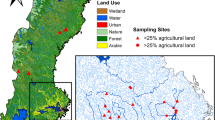A statistical procedure comprising principal component analysis and multiple regression has been applied to the in situ mortality response data for Gammarus pulex caged downstream of a combined sewer overflow (CSO) and a surface water outfall (SWO). The mortality and heavy metal bioaccumulation responses of the species as well as seventeen different chemical and hydrological characteristics of the receiving watercourse were monitored continuously for 36 days. Flow rate, BOD5, suspended solids, total ammonia, total aqueous copper and lead concentrations and dissolved aqueous concentrations of zinc and copper influenced the mortality response of Gammarus pulex. The relationships between the mortality response and the selected independent variables are expressed in the form of stable quantitative equations by regressing the dependent variable (i.e. mortality) against the principal components of the independent parameters. This statistical approach represents an important tool for interpreting large intercorrelated sets of environmental data obtained in situ.
Similar content being viewed by others
References
Bascombe A.D. (1988) Biological monitoring of benthic macroinvertebrates for the assessment of heavy metal pollution in urban rivers. Research Report No 11 Urban Pollution Research Centre, Middlesex University, London.
Bomboi M.T., Hernandez A., Marino F. and Hontoria E. (1990) Application of multivariate analysis for characterization of organic compounds from urban runoff. The Science of the Total Environment 93, 523–36.
Ellis J.B. (1989) The management and control of urban runoff quality. Journal of the Institute of Water Engineers and Management 3, 116–24.
Harrop O. (1984) Stormwater pollution from highway surfaces. Research Report 6. Urban Pollution Research Centre, Middlesex University, London.
Hawkes H.A. (1979) Invertebrates as indicators of river water quality. In Biological indicators of water quality. A.James and L.Evison (eds) New York: Wiley & Sons.
Hvitved-Jacobsen T. (1982) The impact of combined sewer overflows on the dissolved oxygen concentration of a river. Water Res. 16, 1099–105.
Lindholm O. and Aaby L. (1989) In-pipe flushing and their implications for overflow quality. In Water Quality Impact of Storm Sewage Overflows on Receiving Waters. J.B.Ellis (ed) Oxford: Pergamon Press.
Lijklema L., Roijackers R.M.M. and Cuppen J.G.M. (1988) Biological assessment of effects of combined sewer overflows and storm water discharges. In Proceedings of The International Symposium on Hydrological Processes and Water Management in Urban Areas. The Netherlands: IHP/UNESCO.
McMahon C.P., Poulton M.J., Thomas P.C., Xu Q., Pascoe D. and Turner C. (1991) Lethal and sublethal toxicity of field simulated farm waste episodes to several freshwater invertebrate species. Water Res. 25, 661–71.
Morandi M. (1991) Comparison of two multivariate modelling approaches for the source apportionment of inhalable particulate matter in Newark NJ. Atmospheric Environment 25A, 927–37.
Morrison G.M. (1983) Speculation studies of natural waters: A review. Research Report No 8. Urban Pollution Centre, Middlesex University, London.
Morrison G.M. and Revitt D.M. (1987) Assessment of metal species bioavailability and geochemical mobility in polluted waters. Environmental Technology Letters 8, 361–72.
Mulliss, R.M. (1994) The ecotoxicological impacts of urban discharges. PhD Thesis, Urban Pollution Research Centre, Middlesex University.
Nilson L. (1974) The energy budget of a laboratory population of Gammarus pulex. Oikos 25, 35–42.
Saul A.J. and Thornton R.C. (1989) Hydraulic performance and control of pollutants discharged from a combined sewer storage overflow. Water Science & Technology 21, 747–57.
Thomann R.V. and Mueller J.A. (1987). Principles of surface water quality modelling and control. New York: Harper & Row.
Williams K.A., Green D.W.J. and Pascoe D. (1986) Studies on the acute toxicity of pollutants to freshwater macroinvertebrates 3. Ammonia. Archives of Hydrobiology 106, 61–70.
Winner R.W. (1985) Bioaccumulation and toxicity of copper as affected by interactions between humic acid and water hardness. Water Res. 19, 449–55.
Zeng and Hopke (1992) The application of three-mode factor analysis (TMFA) to receptor modelling of the SCENES particle data. Atmospheric Environment, 26A (9) 1701–11.
Author information
Authors and Affiliations
Rights and permissions
About this article
Cite this article
Mulliss, R.M., Revitt, D.M. & Shutes, R.B.E. The determination of the toxic influences to Gammarus pulex (amphipoda) caged in urban receiving waters. Ecotoxicology 5, 209–215 (1996). https://doi.org/10.1007/BF00116341
Received:
Accepted:
Issue Date:
DOI: https://doi.org/10.1007/BF00116341




